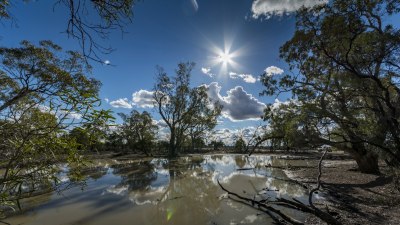What Makes Clouds So Dramatic Before Sunset
Explore the science behind the stunning cloud formations that appear during sunset.

This image was created with the assistance of Freepik
Clouds are often thought of as simple accumulations of water droplets or ice crystals suspended in the atmosphere. However, their presence can evoke a range of emotions, especially when enhanced by the warm glow of a sunset. This article delves into the various elements that contribute to the dramatic appearances of clouds before sunset, examining the interplay of light, atmospheric conditions, and the types of clouds that take center stage during this magical time of day.
The Science of Clouds
To truly appreciate the drama clouds can produce, it is essential to understand their formation. Clouds form when water vapor in the air cools and condenses into tiny droplets or ice crystals. This process is influenced by factors such as temperature, humidity, and atmospheric pressure. The resulting clouds can vary greatly in appearance and structure, depending on these conditions.
Types of Clouds
There are many types of clouds, each with its unique characteristics. Some of the most dramatic clouds encountered at sunset include cumulonimbus, cirrus, and stratus clouds. Cumulonimbus clouds are towering and can reach great heights, often indicating thunderstorms. Their anvil-shaped tops can reflect sunlight in vibrant colors, creating breathtaking displays as the sun sets. In contrast, cirrus clouds are thin, wispy, and often appear high in the atmosphere. They can catch the last rays of sunlight, exhibiting fiery reds, oranges, and pinks. Stratus clouds, while typically gray and uniform, can also vary in color at sunset, particularly when illuminated from below.
The Role of Light
The dramatic nature of clouds during sunset is significantly influenced by the angle and quality of light. As the sun descends below the horizon, its light passes through a greater depth of atmosphere. This increased distance causes scattering of shorter wavelengths of light, such as blues and greens. The longer wavelengths, including reds and oranges, dominate the sky, creating a stunning backdrop for any clouds present. When the light hits clouds, particularly those with larger surfaces like cumulonimbus, it can create a spectacular array of colors and contrasts.
Atmospheric Conditions
Various atmospheric conditions also contribute to the drama of clouds at sunset. Humidity plays a vital role; higher humidity levels can lead to more dramatic cloud formations. When humidity is high, cloud droplets can grow larger, and the cloud’s surface can become more textured, catching and reflecting light in unique ways. Furthermore, the presence of dust and pollutants in the atmosphere can enhance sunset colors, as these particles scatter light differently than clean air. Cleaner air can yield soft pastel sunsets, while particles can create rich, vibrant hues.
The Influence of Weather
Weather patterns significantly influence cloud formations and their appearance at sunset. As a storm approaches, the sky may become laden with heavy, dark clouds. This backdrop can create a profound contrast with the warm colors of the sunset, enhancing the overall visual impact. Conversely, post-storm events often provide clarity and openness in the atmosphere, resulting in vivid, clear sunsets that illuminate high cirrus clouds. The interplay of the impending weather and the retreating sun creates a dynamic canvas for breathtaking views.
The Geographic Impact
The geographic location also plays a crucial role in the appearance of clouds during sunset. Coastal areas, for instance, often experience different cloud types compared to mountainous or flat regions. In coastal regions, marine stratus clouds can blanket the horizon, capturing radiant colors as the sun sets. Similarly, mountainous regions can enhance cloud formations, as geographical elevation can create unique wind patterns and atmospheric disturbances, leading to powerful displays at sunset.
Photography and Cloudy Sunsets
For photographers and nature lovers alike, capturing the essence of clouds during sunset can be a deeply rewarding experience. The unpredictable nature of weather means that the best opportunities often arise spontaneously. Techniques such as using filters can amplify the colors of the sunset and bring out the details in the clouds. Photographers should pay attention to the composition of their shots, considering how the clouds interact with both the landscape and the horizon line. It can be beneficial to arrive at a location early, allowing time to scout different angles and perspectives.
The Emotional Connection
Clouds before sunset evoke emotional responses and can serve as metaphors for different experiences in life. They remind us of transience, beauty, and the fleeting nature of time. The captivating visual display of light and shadow can create feelings of both awe and introspection, prompting people to pause and reflect. Many find solace in watching sunsets, using the moment as an opportunity to unwind and contemplate. This emotional connection to the beauty of clouds at sunset can foster a deeper appreciation of nature.
In conclusion, the drama of clouds before sunset is a spectacle shaped by a multitude of factors, including cloud types, light conditions, weather patterns, and geographic influences. Each sunset presents a unique opportunity to witness the interaction between these elements, resulting in stunning and ever-changing visuals that captivate observers. By understanding the science and beauty behind clouds, we can enhance our appreciation and create lasting memories that accompany these beautiful natural displays.











